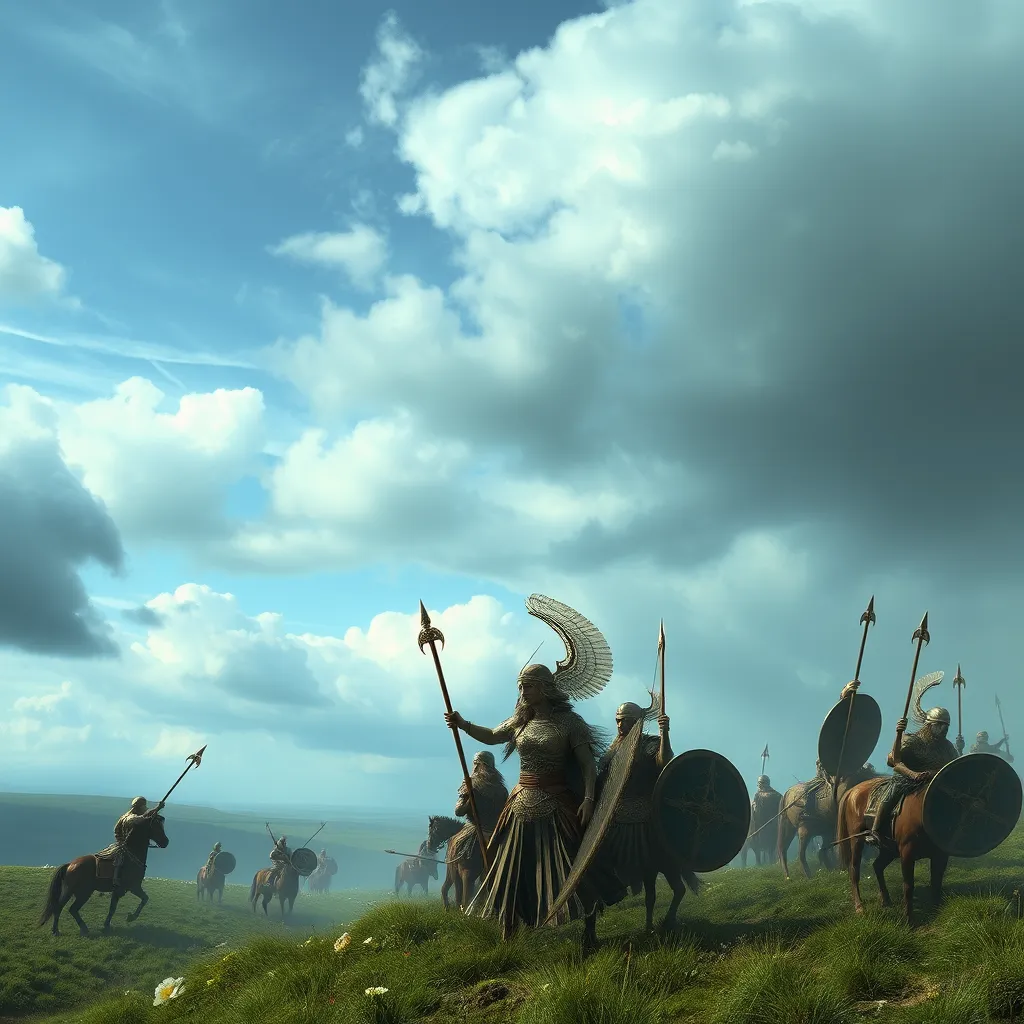The Valkyries of Germanic Mythology: A Look at the Warriors of the Old Saxons and Franks
I. Introduction
The Valkyries hold a prominent place in Germanic mythology, often depicted as fierce warrior maidens who serve the god Odin. These supernatural figures are best known for their role in selecting those who may die and those who may live in battles, guiding the souls of slain warriors to the afterlife. In the cultures of the Old Saxons and Franks, the Valkyries represented not only the martial spirit of women but also the intertwining of fate and honor.
Understanding the significance of Valkyries in these ancient cultures sheds light on their values, beliefs, and societal structures. This article aims to explore the multifaceted role and enduring significance of Valkyries in the historical contexts of the Old Saxons and Franks.
II. Historical Context of the Old Saxons and Franks
The Old Saxons and Franks were two prominent Germanic tribes that played significant roles in shaping early medieval Europe. The Old Saxons inhabited the northwestern regions of what is now Germany, while the Franks were primarily located in modern-day France and Belgium.
During the Viking Age, these tribes experienced a sociopolitical landscape characterized by frequent warfare, territorial expansion, and alliances. As they navigated conflicts among themselves and with neighboring cultures, the role of warrior figures, including Valkyries, became deeply embedded in their societal narratives.
The arrival of Christianity in the region also had a profound impact on pagan beliefs, including the mythology surrounding Valkyries. As Christian missionaries spread their faith, many pagan traditions were either adapted into the new religion or suppressed altogether, leading to a gradual transformation of cultural identities.
III. The Mythological Role of Valkyries
Valkyries are often described as beautiful, fierce maidens, clad in armor and riding swift horses. Their primary function was to serve Odin by choosing which warriors would die in battle and which would be spared. This selection process was not arbitrary; it was believed that only the bravest and most honorable warriors would be chosen to join Odin in Valhalla, the hall of the slain.
In addition to their role as choosers of the slain, Valkyries also had connections to the afterlife. They were often seen as guides for the souls of fallen warriors, escorting them to Valhalla, where they would prepare for the final battle during Ragnarok. This association with fate and the afterlife made Valkyries powerful symbols within Germanic mythology.
IV. Valkyries in Literature and Art
Valkyries have been depicted in various forms of literature and art throughout history. In Old Norse sagas and poetry, they are featured prominently, often characterized by their strength, beauty, and complex personalities. For example, the poem “Völuspá” from the Poetic Edda highlights their vital role in the fate of warriors.
Artistic representations of Valkyries can also be found in medieval manuscripts, where they are often illustrated alongside battles or in scenes depicting Valhalla. These visuals showcase their warrior spirit and divine beauty, cementing their status as iconic figures in Germanic lore.
When comparing Saxon and Frankish traditions, there are some differences in the portrayal of Valkyries. While both cultures revered these warrior maidens, the Franks often emphasized the chivalric aspects of their nature, intertwining them with ideals of courtly love and heroism. In contrast, Old Saxon depictions tended to focus more on their martial prowess and connection to fate.
V. Valkyries as Symbols of Female Empowerment
The duality of femininity and warrior spirit embodied by Valkyries presents a fascinating study of gender roles in ancient societies. In a time when women were primarily viewed through the lens of domesticity, Valkyries broke stereotypes by representing strength, bravery, and independence.
These mythical figures served as role models for women, demonstrating that they could possess both nurturing qualities and martial might. The idea of women wielding swords and choosing the fates of men challenges modern perceptions of gender in historical contexts.
In contemporary feminist discourse, Valkyries have been reinterpreted as symbols of female empowerment. Modern interpretations often highlight their agency and strength, serving as inspirations for women seeking to reclaim powerful narratives in history and mythology.
VI. The Influence of Valkyries on Contemporary Culture
In recent years, Valkyries have experienced a resurgence in popularity within modern literature, film, and gaming. Their compelling narrative of strength and choice resonates with contemporary audiences, leading to their inclusion in various media forms.
- Literature: Valkyries frequently appear in fantasy novels, often portrayed as powerful warriors or mystical beings.
- Film: Movies such as “Thor” have popularized Valkyries, showcasing their warrior skills and connection to Norse mythology.
- Gaming: Video games often feature Valkyries as playable characters or significant figures in plots involving Norse mythology.
This resurgence of interest in Norse mythology emphasizes the cultural relevance of Valkyries today, influencing popular culture and identity. As societies continue to explore themes of empowerment and strength, Valkyries remain emblematic of the warrior spirit.
VII. The Legacy of Valkyries in Germanic Heritage
The legacy of Valkyries persists in modern Germanic paganism, where they are remembered and celebrated as part of a rich mythological tradition. Many contemporary practitioners of Germanic neopaganism honor the Valkyries in rituals and ceremonies, recognizing their role as guides and warriors.
Valkyries also play a significant role in cultural festivals and celebrations, particularly in regions with strong ties to Germanic history. Events celebrating the Norse heritage often feature Valkyrie-themed activities, performances, and storytelling, enriching community ties and cultural identity.
In contemporary society, the preservation of Valkyrie myths continues through literature, art, and public discourse. Their stories are retold and adapted, ensuring that these powerful figures remain a vital part of cultural narratives.
VIII. Conclusion
The significance of Valkyries in Old Saxon and Frankish culture highlights their multifaceted roles as symbols of strength, honor, and femininity. As choosers of the slain and guides to the afterlife, they embodied the values of bravery and fate that were central to these societies.
Reflecting on the enduring legacy of Valkyries, it is clear that their stories and symbolism continue to resonate in modern society. From literature to popular culture, the relevance of Valkyries is undeniable, serving as reminders of the powerful roles women can hold in mythology and history.
Ultimately, the legacy of Valkyries invites contemporary audiences to explore themes of empowerment, choice, and the complexities of identity, ensuring their place in both past and present narratives.



